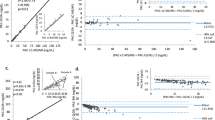Abstract
WE have previously suggested that immunologically reactive fragments of angiotensin II may arise in blood during the metabolism of the octapeptide by angiotensinases and that such an occurrence could compromise the measurement of blood angiotensin II by radioimmunoassay1. This proposal regarding the presence of angiotensin II fragments in blood has now been investigated by paper chromatography of ethanolic blood extracts and radio-immunoassay of eluates from serial sections along the chromatograms to detect immunoreactive angiotensin II fragments. The octapeptide angiotensin II was the predominant peptide detected in arterial blood samples from six human subjects and nine sheep, being 85 and 96 per cent of the total immunoreactivity respectively. In contrast to this finding in arterial blood, angiotensin II was a minor component in the chromatographic pattern of extracts of venous blood from six human subjects, comprising only 28 per cent of the total immunoreactivity. The major immunoreactive component present in venous blood possessed the mobility of the (3–8) hexapeptide of angiotensin II. These results indicate that radioimmunoassay of angiotensin II in ethanolic arterial blood extracts gives values which are close to the amount of the octapeptide actually present. The same radioimmunossay may, however, substantially over-estimate the true level of the octapeptide present in venous blood because of interference by the immunoreactive metabolites of angiotensin. The arterio-venous difference of the chromatographically isolated angiotensin II measured by the radioimmunoassay is consistent with bioassay observations that approximately two-thirds of the circulating angiotensin II is extracted and metabolized across tissue vascular beds. Measurement of the total immunoreactive angiotensin content of venous blood by radioimmunoassay of angiotensin II shows moderately good correlation with the arterial level of the octapeptide, and is probably adequate for clinical studies. Radioimmunoassay of blood angiotensin II during physiological studies on the role of angiotensin II in vascular and hormonal regulation should, however, be performed on arterial blood samples in order to obtain a true estimate of the concentration at which the octapeptide is presented to its target tissues.
This is a preview of subscription content, access via your institution
Access options
Subscribe to this journal
Receive 51 print issues and online access
$199.00 per year
only $3.90 per issue
Buy this article
- Purchase on Springer Link
- Instant access to full article PDF
Prices may be subject to local taxes which are calculated during checkout
Similar content being viewed by others
References
Catt, K. J., Cain, M. D., and Coghlan, J. P., Lancet, ii, 1005 (1967).
Author information
Authors and Affiliations
Rights and permissions
About this article
Cite this article
CAIN, M., CATT, K. & COGHLAN, J. Immunoreactive Fragments of Angiotensin II in Blood. Nature 223, 617–618 (1969). https://doi.org/10.1038/223617a0
Received:
Revised:
Issue Date:
DOI: https://doi.org/10.1038/223617a0
This article is cited by
-
Synthesis and effects of active fragments of angiotensin II
Kidney International (1997)
-
Bestimmung der Plasmareninaktivit�t durch radioimmunologischen Nachweis von Angiotensin I
Klinische Wochenschrift (1971)
-
The Renin–Angiotensin System: Inhibition of Converting Enzyme in Isolated Tissues
Nature (1970)
Comments
By submitting a comment you agree to abide by our Terms and Community Guidelines. If you find something abusive or that does not comply with our terms or guidelines please flag it as inappropriate.



